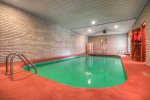Cool - thanks! I'm probably basing this just on the color scheme, but it has a 70's look...? My house is very 70's. I like to tell people that at one time Cheryl Tiegs parked her Mustang II in the driveway, walked in wearing platform shoes and did a line of coke on the groovy bathroom counter before taking a swim. Most people seem willing to believe it...

My pool gets
some sun. Not much and not for long though.
I don't use or heat the pool in the summer. FC doesn't change much without sun, bather load and at 68
º. I tested with the OTO kit to save powder. I'd lose about 2-3 ppm a week.
That's ah, interesting plumbing for sure!
You mentioned that your equipment is in the basement? So is mine. My plumbing looks much better than that, but after getting a new pump professionally installed last Feb, I heard a high-pitched beep in the house.
A union on my new, nice-looking plumbing had split. Pool water was shooting across the room and fortunately in the direction of a $12, 9-volt water alarm that the previous owners had placed next to the water heaters.
I bought more of those alarms and fresh batteries for them, and also a WiFi-enabled water alarm that will send an alert to my phone if it detects water. Great peace of mind!




![KIMG0278[1].jpg KIMG0278[1].jpg](https://www.troublefreepool.com/data/attachments/57/57563-0dfbc0436a775a4e6284961a4fbceff5.jpg)
